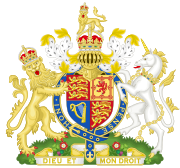
The motto appears on a representation of the garter, surrounding the shield of the Royal coat of arms of the United Kingdom.

The motto appears in another heraldic shield on the ceiling of Bath Abbey.
"Honi soit qui mal y pense" sometimes rendered as "Honi soit quy mal y pense", "Hony soyt qe mal y pense", "Hony soyt ke mal y pense", "Hony soyt qui mal pence" and various other phoneticizations, is the motto of the English chivalric Order of the Garter. In the French Language it is rendered as "Honni soit qui mal y pense" (the modern conjugation of the verb honnir being honni).[1] It is also written at the end of the manuscript Sir Gawain and the Green Knight but it appears to have been a later addition.[2] Its literal translation from Old French is "Shame be to him who thinks evil of it",[3] or more strictly: "Let he who thinks ill there be shamed." It is sometimes re-interpreted as "Evil be to him who evil thinks".[4]
History[]
This statement supposedly originated when King Edward III was dancing with his first cousin, Joan of Kent. Her garter slipped down to her ankle, causing those around her to snicker at her humiliation. In an act of chivalry Edward placed the garter around his own leg, saying "Honi soit qui mal y pense", and the phrase later became the motto of the Order.
Translation[]
It may be understood as 'A scoundrel, who thinks badly by it', or 'Shame on him, who suspects illicit motivation'. Today it is also used to express a slightly ironic sentiment about seemingly, but not explicitly related statements or events. Examples might be a story containing a double entendre, in which the teller 'warns' against the licentious interpretation. It can also be used to point out, by ironically denying, the actual relation of actions. If a politician were to argue the national benefit of a government program - which would happen to bring great investments to a particular county; the county where that politician happens to hail from: Then you'd be 'a scoundrel' to think anything but the 'national benefit' was the true motivation.
Another alternative translation : "Spurned be the one who evil thinks". The older (dark navy blue) British passport carried this message on its cover. The intent there was for the bearer to be pure in thought and intent if he/she was a carrier of that passport.
Heraldic use[]
The motto of the Order appears on a representation of the garter, surrounding the shield, on the Royal coat of arms of the United Kingdom, the motto of the Royal arms, Dieu et mon droit, being displayed on a scroll beneath the shield. Several British Army regiments also use the motto of the Order of the Garter, including the Royal Horse Artillery, Grenadier Guards, Royal Regiment of Fusiliers, Princess of Wales' Royal Regiment, Life Guards and the Blues and Royals. The Canadian Grenadier Guards, The Royal Regiment of Canada, The Royal Montreal Regiment and New Zealand's 6th Hauraki Infantry Regiment also use it as their mottos.
It is on the front of the current British passports.
Further, the motto is also present on the emblem of the Grenadier Guards, The Times (London), Corps of Royal Engineers, the Royal Australian Engineers, and the Royal Australian Army Ordnance Corps and is denoted on a circular belt, surrounded by a wreath, with the crown jewels atop.
The motto was also used as on the official emblem of the South Australian Railways.
The motto was also used on the official emblem of the Royal Yacht Britannia.
The motto appears on the coat of arms of the British Columbia Supreme Court.
Other appearances[]
Bounty mutineer James Morrison had the motto with a garter tattooed around his left leg, according to William Bligh's Notebook
The motto also appears on the entry gates to pop star Michael Jackson's Neverland estate, emblazoned on his personal crest beneath a royal lion and a gemstone-collared unicorn.[5]
See also[]
- Ich dien, the motto on the Prince of Wales's feathers
- Dieu et mon droit, the motto of the British Monarch
- List of state mottos
References[]
- ↑ http://www.wordreference.com/conj/FRverbs.asp?v=honnir
- ↑ Waldron, Ronald Alan, editor (1970). Sir Gawain and the Green Knight. Evanston, Illinois: Northwestern University Press. pp. 139. ISBN 9780810103283. http://books.google.com/books?id=99-SAHCAMmoC&printsec=frontcover&source=gbs_summary_r&cad=0#PPA139,M1. OCLC 135649
- ↑ "Order of the Garter". Encyclopedia Americana. XII. New York: Encyclopedia Americana Corp.. 1919. pp. 300. http://books.google.com/books?id=NmQMAAAAYAAJ&printsec=titlepage&source=gbs_summary_r&cad=0#PPA300,M1.
- ↑ Thomas, Tayler (1866). "Equites Garterii". The Law Glossary: Being a Selection of the Greek, Latin, Saxon, French, Norman, and Italian Sentences, Phrases, and Maxims, Found in the Leading English and American Reports and Elementary Works: With Historical and Explanatory Notes : Alphabetically Arranged, and Translated into English, for the Use of the Members of the Legal Profession, Law Students, Sheriffs, Justices of the Peace, Etc. Etc.. New York: Baker, Voorhis & Co.. pp. 183. ISBN 1886363129. http://books.google.com/books?id=ApPTyWXqOygC&printsec=frontcover&source=gbs_summary_r&cad=0#PPA183,M1.
- ↑ http://www.juliensauctions.com/auctions/2009/michael-jackson/icatalog1
The original article can be found at Honi soit qui mal y pense and the edit history here.